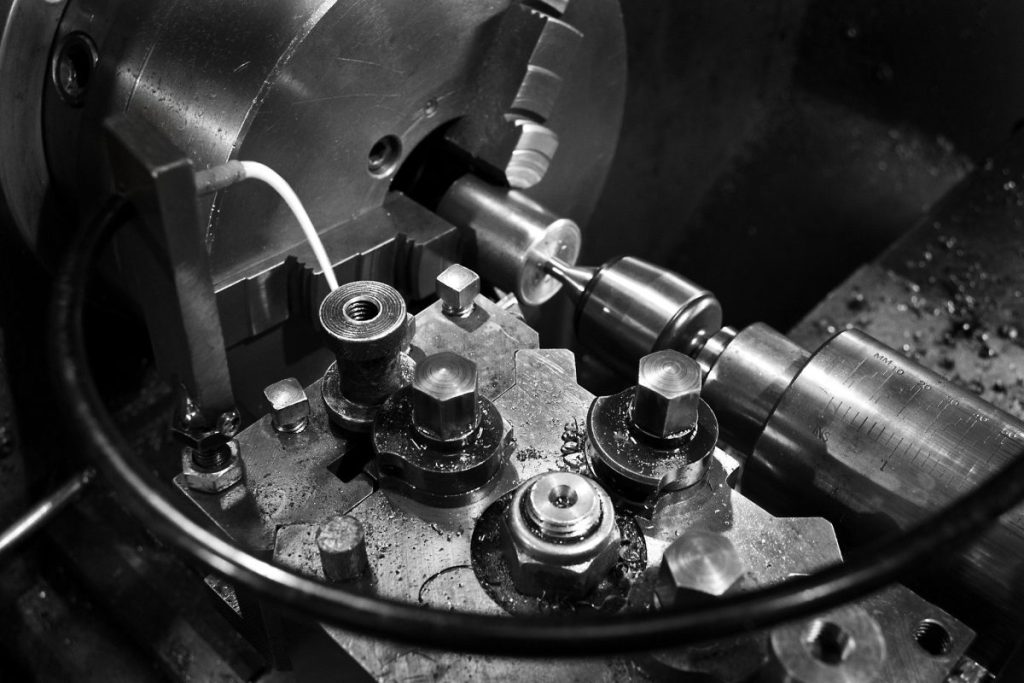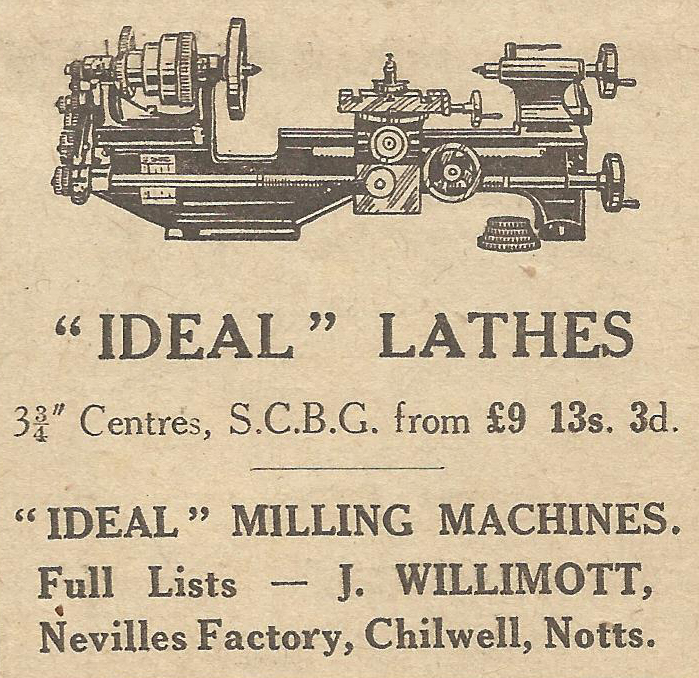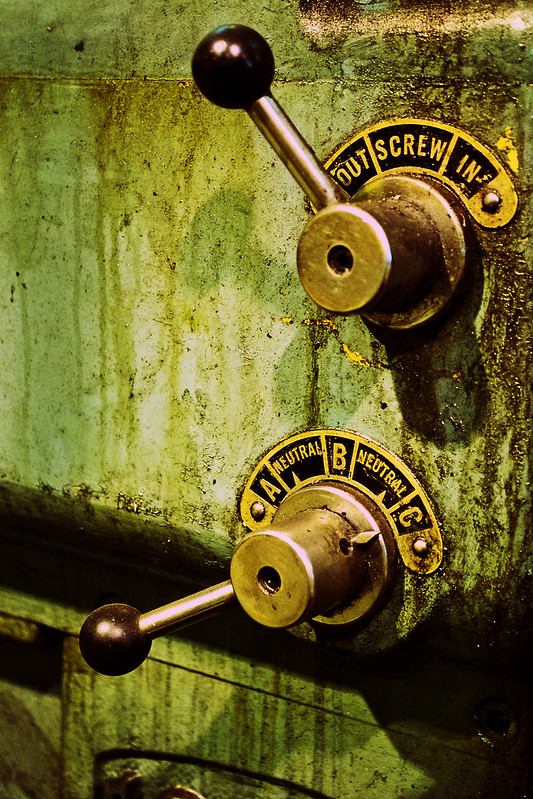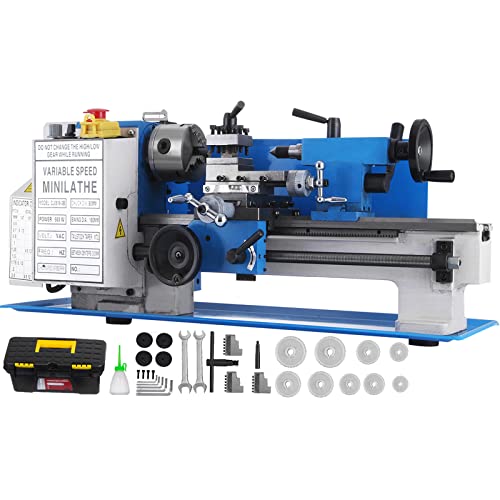- ⭐ Best Midi Lathe Overall: BestEquip Metal Lathe 8″x16″ Benchtop
- 💪 Best Midi Lathe for Power Users: Jet BDB-1340A
- Best Mini Lathe for Hobbyists: BestEquip Metal Lathe 7″x14″ Mini Metal Lathe
- ⭐ Best Mini Lathe Overall: Grizzly G8688 Metal Lathe 7″x12″
- Best Mini Lathe for Power Users: Erie Tools 7″x14″ Precision
- 👛 Best Budget Mini Lathe: Central Machinery Precision Mini Lathe
In this post, I go over the best metal lathes currently on the market. Some of these sometimes go out of stock, so please point that out in the comments below and I’ll look for a different link.

How to Choose a Metal Lathe
A metal lathe is one of the most fundamental tools used to precisely and accurately work metal projects.
While all metal lathes have common features, there is a wide variety of types, sizes, weights, and functionality, which can confuse a hobbyist metalworker.
To choose the best metal lathe for your needs, you should ask yourself these questions:
- What materials are you planning to use the metal lathe for? Just metal? Or metal and wood?
- What size projects are you planning to work with?
- Do you really need a fully-automated machine? Or is a simple machine better suited to your needs?
Not all metal lathes are made equal. Some are only phenomenal at working metal, while others have the versatility to work metal and other materials, too.
Best Overall: BestEquip Metal Lathe 8″x16″ Benchtop Metal Lathe
- Infinitely Variable Speed: The mini metal lathe with metal gears is driven by powerful motor. Variable Speed: 0-2250RPM. The LED screen shows you a clear and accurate speed for accurate working....
- 400mm Large Swing Range: The benchtop lathe is equipped with a 3-jaw chuck. Swing Over Bed: 8-1/4" (210 mm) and Swing Over Cross Slide: 15-3/4" (400mm) offers more possibilities for large size or/and...
- Professional Compound Rest: The mini lathe machine quick change tool post can achieve positions of internal cutting, face cutting, and bevel cutting by changing the tool post angle and adjusting the...
- Supportive & Protective: Soft start, change-over switch for clockwise or counter-clockwise spindle rotation. Equipped with all-metal gears. Steady rest works as end support ensuring chatter-free...
- Adjustable Tailstock: Taper in Tailstock Spindle: MT2. Rotate the lever clockwise to lock the spindle and rotate clockwise to advance the handwheel. To off-set the tailstock for cutting tapers by...
Resting behind the 8″x16″ metal lathe is a powerful motor, which generates a variable speed between 0-2250 RPM. The motor works at 750W and produces a variety of spindle speeds, with a low range of 50-1250 RPM to a high range of 100-2500 RPM.
This powerful mini benchtop metal lathe provides you with a generous working capacity, with a Swing Over Bed of 8-1/4″ and a Swing Over Cross Slide of 15-3/4″. It’s suitable for large, heavy workpieces.
The adjustable tailstock allows you to easily set up your lathe to provide adequate support for your workpiece, with a few simple lever adjustments.
The design of the BestEquip Metal Lathe 8″x16″ has been kept simple and user-friendly. Like any lathe, it will need some initial set-up so do consult the user manual.
However, the LED screen keeps you informed with a clear and accurate speed reading. The box also includes a quick change tool, which allows you to quickly and easily switch between tasks such as internal cutting, face cutting, or bevel cutting.
The BestEquip 8″x16″ Lathe has a solid construction and is very durable. No detail has been overlooked, including the supply of a brushless motor, which means your machine will experience less wear and tear compared to other models. It includes metal gears, which can be longer-lasting than plastic gears.
Safety features also rank favorably, with a soft start on the motor so that the tool is not running on full power immediately, a backsplash guard, and steady rest works.
Conclusion: This is a durable mini metal lathe with similar functionality to a professional-quality lathe, without the huge initial outlay.
With the BestEquip 8″x16″ Lathe, you can be confident that you’ll have complete control over every aspect of your project.
Pros
- Made from stainless steel, the BestEquip 8″x16″ Lathe is durable and reliable
- Easy to use with some support from the user manual – ideal for professionals and hobbyists
- Features variable speed spindle for high precision
- Versatile for multiple applications – can be used on both metal and wood
Cons
- There’s a steep learning curve for the initial setup
Specifications
- Capacity: 8-1/4″ swing and 16″ between centers
- Motor Power: 750 W, 110V, 60Hz
- Phase: Single Phase
- Swing Over Cross Slide: 15-3/4″
- Spindle Bore: 0.83″
- Spindle Accuracy: 0.0004-0.0012″ (0.01-0.03 mm)
- Spindle Taper: MT5
- Tailstock Taper: MT2
- Spindle Speed Range: Low 0-1250 RPM, High 100-2250 RPM
- Travel: Cross slide 3″ (76mm)
- Metric Threads: 8-44 TPI
- Weight: 170lbs
- Dimensions: 38″ x 20″ x 20″
- Warranty: Contact the seller
Best Midi-Lathe for Power Users: Jet BDB-1340A
- Automatic feeding and threading are fully interlocked
- Carriage mounted spindle control lever
- Centers and headstock center sleeves
- Feed selectors travel in grooved ways
- Independent lead screw and feed rod
Common problems with most metal lathes include noise and vibrations. The Jet BDB-1340A features an enclosed gearbox with helical gears, which results in both noise reduction and smooth operation.
The Jet BDB-1340A lathe is a 1-phase belt drive bench metalworking lathe. As well as a machine that’s built with precision, you’ll get a flexible, user-friendly machine.
The Jet BDB-1340A lathe enables you to make quick, easy speed changes, with its 12 variable speed motor. It includes a micro carriage bed stop and features a v-way bed. The tailstock can be offset for turning tapers, while a threading dial ensures that your workpiece and the carriage are lined up for more accuracy.
The Jet BDB-1340A includes a 6″ 3-jaw chuck with top reversing jaws, an 8″ 4-jaw chuck, a 12″ faceplate, and a four-way tool post as standard. It comes with everything you need to get started and hence, is one of the top-notch metal lathes available on the market.
Jet provides some useful safety features, so you can feel confident about using the machine. An emergency stop button is available on the headstock. A full-length splash guard prevents hot chips and fluid from contaminating your work area. The machine also benefits from a low-voltage motor box.
Conclusion: The Jet BDB-1340A is an excellent, reliable tool for serious hobbyists. With a distance between centers of 40″, you’ll be able to work on a range of mid-sized projects.
Pros
- Excellent noise reduction making this a comfortable tool to use for long periods
- The easy-to-understand gearbox allows you to make adjustments quickly
- Helical cutting tools deliver a smooth operational experience
- Includes a gap bed extension for extra versatility
Cons
- At the pricier end of the metal lathes reviewed
- A very steep learning curve, so may not be suitable for complete beginners
Specifications
- Capacity: 13″ swing and 40″ between centers
- Motor Power: 2 HP, 230V, 1Ph
- Phase: Single Phase
- Swing Over Cross Slide: 7-25/32″
- Spindle Bore: 1-3/8″
- Spindle Taper with Sleeve: MT5 (MT3)
- Tailstock Taper: Mt3
- Spindle Speed Range: 12, 60-1,240 RPM
- Metric Threads: 0.45-10 TPI
- Weight: 1,175lb
- Dimensions: 71″ x 32″ x 45″
- Warranty: Limited 2 Year (Mechanical), Limited 1 Year (Electrical)
Additional Specifications
- Swing Through Gap: 18-3/4″
- Length of Gap: 8″
- Carriage Travel: 35″
- Width of Bed: 7-3/8″
Best Mini Lathe for Hobbyists: BestEquip Metal Lathe 7″x14″ Mini Metal Lathe
- Sturdy Aluminium Construction: The mini metal lathe bed is made of high grade iron. Equipped with nylon gears, this lathe machine is wear-resistant, sturdy, more accurate rotation and professional....
- Infinitely Variable Speeds: Spindle speed from 0-2250 RPM. Forward and reverse in all speeds. Operate either manually or with the adjustable auto feed rate. The hardness and accuracy of the v-slide...
- Accurate 3-Jaw Chuck: Mini metal lathe chuck, 3-jaw self-centering chuck, for setting cylindrical materials steadily. Back splash guard included. Spindle is supported by precision tapered roller...
- Professional Compound Rest: The mini metal lathe quick change tool post can achieve positions of internal cutting, face cutting and bevel cutting by changing the tool post angle and adjusting the...
- Wide Application: Driven by DC motor, this mini metal lathe cut off tool can be used in areas such as mini precision parts processing, sample processing and modeling works.
BestEquip’s 7″x14″ lathe is the slightly smaller cousin to the 8″x16″. It’s more compact and lighter, making it more suited for bench tops.
Made from high-grade iron, this machine is very durable for the price tag. The nylon gears are lightweight, resistant to wear and tear and offer professional and accurate rotation.
But, don’t let its size fool you!
It still packs a powerful punch with its 550W, 110V brushless motor. This hardworking motor is capable of producing infinitely variable speeds between 0-2250 RPM, in both forward and reverse directions. The variable speed can be controlled by the machinist manually or with an adjustable auto feed rate.
This versatile metal lathe is suited to working with a variety of materials, including metal and wood. It can even be used to cut jade!
The BestEquip mini metal lathe includes a 3-jaw chuck which allows you set cylindrical materials easily.
Similar to the 8″x16″ metal lathe, the quick change tool means you can set and reset the position and angle of your workpiece quickly, saving valuable work time.
Standard safety features include a backsplash guard and an emergency stop button.
Conclusion: Another durable metal lathe, the BestEquip 7″x14″ is a compact benchtop mini metal lathe that is reliable and versatile. It’s an ideal tool for making mini precision parts, small samples, and home projects. This lathe is best suited to entry-level hobbyists on a budget.
Pros
- Includes a unique jaw chuck with three adjustable jaws
- Multi-functional machine
- Delivers high accuracy and good quality products with precision tapered roller bearings
- Includes a rotatable turret
Cons
- Requires additional supervision to ensure workpieces are set correctly
Specifications
- Capacity: 7″ swing and 14″ between centers
- Motor Power: 550W, 110V DC
- Phase: Single Phase
- Swing Over Cross Slide: 110mm
- Spindle Bore: 0.83″
- Spindle Accuracy: 0.0004″ / 0.01 mm
- Spindle Taper: MT3
- Tailstock Taper: MT2
- Spindle Speed Range: 0-2250 RPM
- Travel: Cross slide 2.53″ (65mm)
- Metric Threads: 12-52 TPI
- Weight: 102.7 lbs
- Dimensions: 29.4″ x 8.7″ x 10.8″
- Warranty: Contact the seller
Best Mid-Budget Mini Lathe: Grizzly G8688 Metal Lathe 7″x12″
- Variable Speed
- 16 TPI Reversible Lead screw
- Forward and reverse in all speeds
- Chip Tray and Backsplash Guard
- Threading Dial Indicator
Grizzly Industrial’s powerful mini lathe is an extremely functional, compact lathe that doesn’t take up too much space on your workbench.
It’s equipped with the same features as larger metal lathes, including inch and metric dials, a turret tool post, a 3″ three-jaw chuck with external jaws, and steady rest.
With a swing of 7″ and a distance between centers of 12″, this mini metal lathe is ideal for small projects.
A variable speed spindle box allows you to quickly set the speed, within the range of 0-2,500 RPM. Offering both forward and reverse directions at all speeds, you’ll find the Grizzly 8688 suited to a wide range of applications.
The Grizzly G8688 is a versatile benchtop mini metal lathe that will allow you to work on multiple projects. While designed for metalworking, this lathe is also great for cutting other materials including plastic and wax!
Safety-wise, you’ll get an emergency stop button and a chip tray, and a splash guard, which helps to keep debris contained. The plastic gears instead of metal gears make the lathe more suitable for new machinists.
Conclusion: Grizzly Industrial has produced a great mini metal lathe, which is highly suitable for hobbyist metalworkers. It’s a good metal lathe that includes all the functions you’d expect from a professional lathe, without the price tag.
Pros
- Variable speed settings
- Forward and reverse at all speeds
- Very lightweight with a small footprint
- Useful dial indicator for threading
Cons
- Very limited by the capacity of 7″x12″
- Like other lathes, there’s a steep learning curve to get to grips with the machine’s functionality
Specifications
- Capacity: 7″ swing and 12″ between centers
- Motor Power: 250W, 3/4 HP, 110V
- Phase: Single Phase
- Swing Over Cross Slide: 2-1/8″
- Spindle Bore: 0.78″
- Spindle Taper: MT3
- Tailstock Taper: MT2
- Spindle Speed Range: Low 0-1100 RPM, High 0-2500 RPM
- Travel: Cross slide 2-3/4″
- Metric Threads: 12-52 TPI
- Weight: 75lbs
- Dimensions: 27-3/4″ x 11-1/2″ x 12″
- Warranty: 1-year
Best Mini Lathe for Power Users: Erie Tools 7″x14″ Precision
- Variable Speed
- 16 TPI Reversible Lead screw
- Forward and reverse in all speeds
- Chip Tray and Backsplash Guard
- Threading Dial Indicator
The Erie Tools 7″x14″ Precision benchtop mini metal lathe features a range of functions that are hard to beat in this price bracket.
A digital readout makes it easy to adjust your RPMs throughout the manufacturing process. A single-phase motor produces infinitely variable speeds up to 2500 RPM, for full control over your workpiece. The variable speed produces good quality products in both rotational directions, forward and reverse.
In addition to many of the standard features common to most metal lathes, you’ll also get a 5-piece carbide cutter kit and a complete set of plastic change gears.
The thread indicator will show you a thread range between 12-52 TPI and offers both imperial and metric pitches. The multi-jaw chuck has excellent grip and you’ll feel confident that your workpiece will be held tightly while you work.
This extremely versatile machine comes with a 5/16″ capacity tool post and enables you to mount four tools simultaneously, so you can substitute your tools quickly as you work.
The 7″ swing and 14″ distance between the headstock and tailstock mean this lathe is more suited to smaller projects but is flexible enough to work with a variety of materials.
Conclusion: Although at the pricier end of our chosen mini metal lathes, you’ll find the Erie Tools 7″x14″ Precision lathe is an excellent investment with a variety of additional tools to help you work efficiently. It delivers smooth, quality results time and time again.
Pros
- A versatile lathe that works on metal, wood, and plastic
- The variable speed spindle box delivers quality results, with excellent precision and smooth results
- Both rotational directions can operate at different speeds
- A digital readout makes it easy to adjust mid-project
Cons
- The 3-jaw chuck may wear out more quickly than other components
Specifications
- Capacity: 7″ swing and 14″ between centers
- Motor Power: 400 W, 0.53HP, 120 V, 60 Hz
- Phase: Single Phase
- Swing Over Cross Slide: 7″
- Spindle Bore: 0.79″
- Spindle Accuracy: 0.0004″
- Spindle Taper: MT3
- Tailstock Taper: MT2
- Spindle Speed Range: 50-2500 RPM
- Travel: Cross slide 2.56″
- Metric Threads: 12-52 TPI
- Weight: 104.2lbs
- Dimensions:
- Warranty: 1-year
Best Budget Mini Lathe: Central Machinery Precision Mini Lathe
- Variable speed control knob
- Automatic feed
- Chuck guard with micro switch
- 0-2500 RPM (high)
Central Machinery does not disappoint with its Precision Mini Lathe. It features an automatic feed, single-phase motor, and variable speed control knob, which gives you total control over your workpiece.
With a swing of 7″ and a center distance of 10″, this lathe is a great performer for making small parts and prototypes – if you’re working in a professional environment, then it’s a great alternative to firing up your industrial-sized metal lathe!
Safety is always paramount and Central Machinery has got you covered! The lathe includes a chuck guard with a micro switch that prevents excess shavings from flying around the workshop.
The lathe is easy to set up with a little know-how and a handy user manual. However, new metal turners may find it more difficult to get the lathe to work properly out of the box.
The initial setup requires you to disassemble the pieces, like the carriage, compound, and cross slide to undertake to get them cleaned up before first use and for the best performance. This can be daunting for new users.
Conclusion: Although there is no such thing as a cheap metal lathe, this is a good entry-level mini lathe that provides all the functionality you’d expect.
Pros
- Comfortable knob to adjust the speed
- Automatic feed
- Chuck guard with a micro switch
Cons
- Requires some maintenance before you can use it for the first time
Specifications
- Capacity: 7″ swing and 10″ between centers
- Motor Power: 3/4 HP, 120V AC
- Swing Over Cross Slide:
- Spindle Taper: MT2
- Tailstock Taper: MT2
- Spindle Speed Range: Low 0-1,100 RPM, High 0-2,500 RPM
- Travel: Cross slide
- Metric Threads: 12-52 TPI
- Weight: 87.05 lbs
- Warranty: 90 Days from the date of purchase
Which is the Best
Choosing the best metal lathe to suit your needs is not always easy, especially if you’re new to the world of metal turning. You can’t beat the BestEquip 8″x16″ mini metal lathe for a mid-range lathe. For heavier usage, I particularly like the Jet BDB-1340A.
Our best advice is to think carefully about the types of projects you’re planning to work on and go from there. A metal lathe can be a big investment and you’ll want to use your lathe for a long, long time!

Frequently Asked Questions
What is a Metal Lathe
In a nutshell, a metal lathe is a machine that rotates a metal workpiece around an axis of rotation. It allows the operator to perform various processes such as cutting, sanding, or drilling.
It’s a versatile tool that allows the craftsman to create an object that is symmetrical about an axis of rotation.
Types of Metal Lathes
There are numerous different types of lathes, which offer various advantages or allow craftsmen to create very niche workpieces.
Here, I cover some of the most common types of metal lathes that you may come across.
A Center Lathe/Engine Lathe/Bench Lathe
Although these lathes all have different names, they’re actually variations of the same basic type of lathe. Consisting of a headstock, bed, carriage, and tailstock, these lathes are the most common type used by general machinists or hobbyists.
A center lathe is a common name for a basic lathe. It features a dual-headed machine that fixes the workpiece at one end, while the heads move the cutting bits toward the workpiece. The benchtop lathe and the engine lathe are variations of the center lathe.
The bench lathe, also known as the benchtop metal lathe, is exactly what it says on the tin. It’s a metal lathe that’s small enough and light enough to be mounted directly to a workbench. But don’t let its size fool you! Although the benchtop metal lathe is small, it still offers the full functionality expected of a metal lathe.
The engine lathe refers to traditional metal lathes that originated in the late 19th and early 20th centuries and introduced automatic feeds to cutting tools. Before this time, lathes were used with hand-held tools or were restricted to manual feeds.
A Toolroom Lathe
The toolroom lathe takes us up the industrial scale of metal lathes. It operates the same way as a center lathe.
However, this machine tool is optimized for toolroom work and so it features all the best functionality that may be required by professional or student machinists. This optimization can increase the lathe’s accuracy, precision, and working speed.
A Turret Lathe
Designed for mass-production projects, the turret lathe is largely used in commercial settings, such as the production of duplicate parts in engineering.
A turret lathe can reproduce the same component over and over again, reliably. Turret lathes have semi-automatic features, which means once they’re set up, they can produce high-quality components with little human intervention.
A Speed Lathe
The speed lathe, again, operates the same way as a standard metal lathe. However, this variation of metal lathe runs faster than the average lathe. This makes them ideal for efficiently working on small, repetitive tasks such as polishing materials or removing burrs.
An Automatic Lathe
Automatic lathes are the ultimate time-savers and one of the most effective types of lathes. Once set up, it just requires someone to supervise since automatic or not, a lathe is a mechanical machine and like any other machine, the mechanical components can occasionally malfunction.

What Should I Consider When Buying a Metal Lathe
Whether you’re a professional machinist looking to add or replace a piece of machinery in the workshop, or a hobbyist machinist just starting out on your metalworking journey, there are a few factors that you need to consider to buy the best metal lathe for you.
Design Considerations
There are many aspects of a metal lathe’s design that you should consider. Ease of use is particularly important, especially if you’re just starting out.
A user-friendly product that does not require reams of technical knowledge means you’re more likely to use the tool. Often, simple is best.
As you become more familiar with metal turning, you can start to consider more complex tools with additional functionality, since these will help you to produce projects with a higher quality finish.
- Size of the headstock and spindle. The headstock houses the main spindle, a speed-changing mechanism, and the lathe’s change gears. It needs to hold your workpiece securely. Some headstocks can be rotated to allow easier outboarding, which can be a real benefit if you need to work with a piece of metal that’s larger than your lathe’s swing capacity.
- Size of the chuck. The chuck is used to hold the workpiece securely, so the size depends on the type of project you have in mind. A small metal ring will not need the same size chuck as a goblet!
- The tailstock. On newer lathes, the tailstock can be an optional feature. If you’re mainly working on smaller projects, you may find the tailstock unnecessary. For larger projects, a tailstock is a crucial component. The tailstock helps to reduce flex in your workpiece, improving the overall structural integrity.
Structural Considerations
When you’re working with high-speed, power machinery, safety should be a key factor in your decision-making process. The structure of the machine heavily contributes to the safety of your metal lathe.
You’ll need a solid structure with sufficient support to hold your workpiece securely.
If you’re going to be using your metal lathe for a long period of time, then comfort should also factor into your decision-making process.
Metal lathes that lack adequate structure may result in vibrations and loud noises, which are all not very pleasant in your working environment! However, these issues can transfer into your workpiece, too, leaving you with an inferior quality end product.
- Lathe bed design. If you’re planning to work on any sizeable projects, you’ll want to consider the lathe bed design. The bed is the lathe’s base, which provides a foundation for the headstock and allows the carriage and tailstock to be moved parallel to the axis of the spindle. Flatbeds are generally used for heavy-duty work, while “V” beds and combination beds are more typically used for light or precision work. Ultimately, your choice of lathe bed will come down to what you’re planning to make and your own personal preference.
- The headstock. This component of the metal lathe needs to be robust enough to withstand the cutting forces involved in turning a piece of metal. If the headstock is too flimsy, it can induce vibrations that transfer to your workpiece, which reduces the quality of your finished product – after all the hard work and effort that went into it, that would be a shame!
- Weight. It may come as a surprise (particularly if you’re just starting your metal-turning journey!) that lathes are heavy! You’ll need to bear this in mind as the weight and dimensions of the machine itself will impact whether you can actually get it into your home workshop, safely. Larger, heavier machines may require an engine lift or small crane to get them into position, and you may need to reinforce the floor.

Functionality Considerations
Before you rush out to buy a new metal lathe, you need to consider what you’ll be using it for as this will have a significant bearing on the type of lathe that you end up acquiring.
- The Carriage, Cross-Slide & Turret. The carriage and cross-slide directly impact the number of axes your lathe can move – usually 2, 3, or 4. The turret determines the number and size of heads the lathe can hold, which in turn influences the size of the workpiece that you can turn comfortably. The larger the workpiece, the larger the heads needed to hold it, which in turn requires larger turrets.
- The Swing. The swing is a common industry measurement that tells you the maximum size of the workpiece that you can turn on your metal lathe. For example, a 3″ x 15″ lathe allows you to work on a piece of metal that’s a maximum of 3″ wide and 15″ long. For hobbyists and home craftsmen, a 3″ x 15″ metal lathe is about as small as you’re going to be able to work with, whereas a 6″x 30″ lathe is as large as you’re going to be able to handle safely at home.
- Power Needs. When you’re considering your requirements for your new metal lathe, not only should you think about the maximum RPMs that the lathe can deliver but also the minimum RPMs. The lathe needs enough power to keep a piece of work turning smoothly but also slow enough that you can control the workpiece safely.





